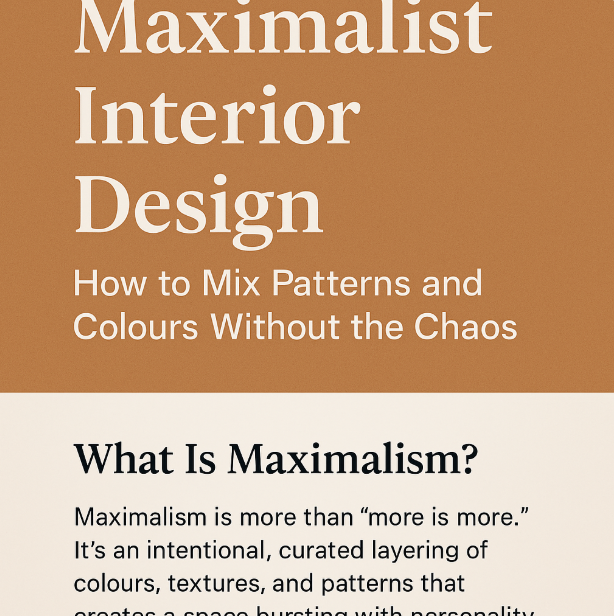Perfect for readers seeking bold inspiration.
What Is Maximalism?
Maximalism isn’t simply “more is more”. It’s an intentional, curated layering of colour, pattern, and texture that tells a personal story. While minimalism pares back, maximalism embraces—welcoming treasured collections, vibrant walls, and rich fabrics. Done right, it feels abundant and considered; done poorly, it can slip into clutter. The secret is controlled creativity.
Start with a Cohesive Colour Palette
Choose two or three dominant colours to anchor your scheme, then add one or two accents for depth. For example, deep teal paired with mustard and blush, lifted by warm metallics. Repeat these hues across paint, upholstery, rugs, and accessories to create cohesion. A deliberate palette prevents the room from feeling haphazard.
Play with Pattern, but Anchor It
Select a “hero” pattern—perhaps a large-scale floral wallpaper or a geometric rug—then introduce mid- and small-scale companions in related colours. Think: bold botanicals with striped cushions and a subtle herringbone throw. Keep at least one colour consistent across patterns to avoid clashes and visual fatigue.
Mix Textures for Richness
Layer velvet, linen, silk, woven grass, wood, and metal to build depth. Contrast is key: a smooth marble table against a jute rug; a brass lamp beside matt-painted walls. Texture gives the eye places to land and keeps print-heavy rooms from feeling flat.
Showcase Your Collections
Maximalism celebrates the personal. Group similar objects—ceramics, vintage cameras, travel mementos—rather than scattering them. Use shelves, plinths, or a gallery wall to create purposeful vignettes. Editing matters: rotate pieces seasonally so each collection gets its moment.
Layer, Don’t Pile
Layering is intentional placement. Gallery walls can overlap but share a frame style or colour. Rugs can be stacked to zone a room, provided they share a hue or texture. Pile cushions in varied sizes and shapes for structure rather than excess. If in doubt, remove one item and reassess.
Use Negative Space
Even exuberant rooms need breathing room. Leave a section of wall bare or choose a simple sideboard to rest the eye. Strategic empty space elevates your bold elements and keeps the overall effect elegant rather than chaotic. Read more about Negative Space here
Lighting Matters
Combine ambient, task, and accent lighting to create warmth and dimension. A statement chandelier, wall sconces, and table lamps working together will highlight textures and patterns while softening shadows. Consider warm-white bulbs for a inviting glow.
Common Pitfalls to Avoid
- Ignoring scale: Balance large, medium, and small pieces to avoid visual clutter.
- Too many colours: Stick to your palette; add interest through texture and shape.
- Flatness: Prints need tactile contrast—add wood, metal, glass, and textiles.
- No focal point: Give the eye a hero—fireplace, sofa, mural, or cabinet of curiosities.
Why Maximalism Works
Maximalism invites joy and individuality. It’s a living archive of your tastes, travels, and history, evolving as you do. With a disciplined palette, anchored patterns, and layered textures, the look is expressive yet refined—never chaotic.
Call to Action
Ready to try it? Start with one room: choose a palette, pick a hero pattern, and layer textures over time. Share your before-and-afters and favourite finds with us—we’d love to feature the boldest transformations in an upcoming issue. Contact Us Here
✍️ Submit a Guest Post
Not a member yet? You can still share your creative voice with our readers. We welcome guest posts from artists, writers, and creative souls of all kinds.
Submit Your ArticleShare this link with your friends if you enjoyed the post 🙂 See the share buttons below to your right

